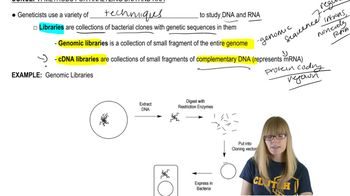Table of contents
- 1. Introduction to Genetics51m
- 2. Mendel's Laws of Inheritance3h 37m
- 3. Extensions to Mendelian Inheritance2h 41m
- 4. Genetic Mapping and Linkage2h 28m
- 5. Genetics of Bacteria and Viruses1h 21m
- 6. Chromosomal Variation1h 48m
- 7. DNA and Chromosome Structure56m
- 8. DNA Replication1h 10m
- 9. Mitosis and Meiosis1h 34m
- 10. Transcription1h 0m
- 11. Translation58m
- 12. Gene Regulation in Prokaryotes1h 19m
- 13. Gene Regulation in Eukaryotes44m
- 14. Genetic Control of Development44m
- 15. Genomes and Genomics1h 50m
- 16. Transposable Elements47m
- 17. Mutation, Repair, and Recombination1h 6m
- 18. Molecular Genetic Tools19m
- 19. Cancer Genetics29m
- 20. Quantitative Genetics1h 26m
- 21. Population Genetics50m
- 22. Evolutionary Genetics29m
18. Molecular Genetic Tools
Methods for Analyzing DNA
Problem 27g
Textbook Question
A family consisting of a mother (I-1), a father (I-2), and three children (II-1, II-2, and II-3) are genotyped by PCR for a region of an autosome containing repeats of a 10-bp sequence. The mother carries 16 repeats on one chromosome and 21 on the homologous chromosome. The father carries repeat numbers of 18 and 26.
What genetic term best describes the pattern of inheritance of this DNA marker? Explain your choice.
 Verified step by step guidance
Verified step by step guidance1
<span>Step 1: Understand the context of the problem. We are dealing with a DNA marker on an autosome, which means it is not sex-linked and is inherited in a Mendelian fashion.</span>
<span>Step 2: Identify the alleles involved. The mother has alleles with 16 and 21 repeats, while the father has alleles with 18 and 26 repeats. These are examples of variable number tandem repeats (VNTRs), which are a type of genetic marker.</span>
<span>Step 3: Consider the inheritance pattern. Since the marker is on an autosome, each child inherits one allele from each parent. This is typical of autosomal inheritance, where alleles are passed down independently of the sex of the offspring.</span>
<span>Step 4: Recognize the genetic term. The pattern of inheritance for this DNA marker is best described as 'autosomal codominant.' This is because both alleles from each parent are expressed in the offspring, and the number of repeats can be directly observed in the genotype.</span>
<span>Step 5: Explain the choice. In autosomal codominance, both alleles contribute to the phenotype, and in this case, the number of repeats from each parent can be detected in the children's genotypes, reflecting the contribution of both parental alleles.</span>
Recommended similar problem, with video answer:
 Verified Solution
Verified SolutionThis video solution was recommended by our tutors as helpful for the problem above
Video duration:
5mPlay a video:
Was this helpful?
Key Concepts
Here are the essential concepts you must grasp in order to answer the question correctly.
Autosomal Inheritance
Autosomal inheritance refers to the transmission of genetic traits that are located on the autosomes, which are the non-sex chromosomes. In this case, the DNA marker in question is located on an autosome, meaning that both parents contribute to the genetic makeup of their children. Understanding this concept is crucial for analyzing how traits are passed down through generations.
Recommended video:
Guided course

Autosomal Pedigrees
Allelic Variation
Allelic variation describes the differences in the DNA sequence among individuals, particularly in the number of repeats in a given region. In this scenario, the mother and father have different repeat numbers (16, 21 for the mother and 18, 26 for the father), which indicates that they possess different alleles for the same genetic marker. This variation is essential for understanding how traits can be inherited in a family.
Recommended video:
Guided course

Genomic Variation
Mendelian Inheritance
Mendelian inheritance is the set of principles that describe how traits are passed from parents to offspring based on the segregation and independent assortment of alleles. In this case, the inheritance pattern of the repeat sequences can be analyzed through Mendelian principles, as the children will inherit one allele from each parent, leading to a combination of the repeat numbers observed in the parents.
Recommended video:
Guided course

Organelle Inheritance

 7:40m
7:40mWatch next
Master Methods for Analyzing DNA and RNA with a bite sized video explanation from Kylia Goodner
Start learningRelated Videos
Related Practice


